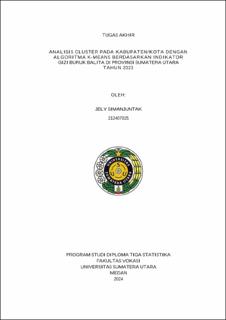Analisis Cluster pada Kabupaten/Kota dengan Algoritma K-Means Berdasarkan Indikator Gizi Buruk Balita di Provinsi Sumatera Utara Tahun 2023
Cluster Analysis in Districts/Cities with K-Means Algorithm Based on Indicators of Malnutrition of Toddlers in North Sumatra Province in 2023

Date
2024Author
Simanjuntak, Jely
Advisor(s)
Nasution, Putri Khairiah
Metadata
Show full item recordAbstract
One of the biggest challenges in global health, especially in developing
countries, is malnutrition in toddlers. This nutritional problem is not just a
statistical number, but has a direct impact on the growth and development of
children in the future. This study aims to (1) Apply the cluster K-means algorithm
method to group districts/cities based on malnutrition indicators of toddlers, (2)
Determine the optimal number of clusters in data grouping, (3) Determine the
variables that have the greatest difference in the clusters formed. There are four
variables measured for this grouping, namely Low Birth Weight (BBLR),
Exclusive Breastfeeding, Posyandu, and Poverty. In this study, the data used are
secondary data from the Sumatra Provincial Health Office and the Central
Statistics Agency (BPS) of North Sumatra Province. Data processing is carried
out with the help of R and SPSS software. From the results of the research of the
K-means algorithm with the help of R software in determining the number of
clusters, 2 clusters were obtained. Cluster 1 with members of the regency/city
group with high levels of malnutrition which contains 3 regencies/cities, namely
Deli Serdang Regency, Lalat Regency, and Medan City. Cluster 2 with members
of the regency/city group with low levels of malnutrition consists of: Nias
Regency, Mandailing Natal, South Tapanuli, Central Tapanuli, North Tapanuli,
Toba, Labuhan Batu, Asahan, Simalungun, Dairi, Karo, South Nias, Humbang
Hasundutan, Pakpak Bharat, Samosir, Serdang Bedagai, Batu Bara, North
Padang Lawas, South Labuhan Batu, North Nias, West Nias, Sibolga City,
Tanjung Balai City, Pematang Siantar City, Tebing Tinggi City, Binjai City,
Padang Sidempuan City, Gunung Sitoli City. Based on the significance value of
each variable with a value less than 0.05 in the ANOVA table, so that the variable
that provides the greatest difference in the two clusters formed is the posyandu
variable, which is with an F value of 125,739 with a significant value of 0.000.
Collections
- Diploma Papers [191]
